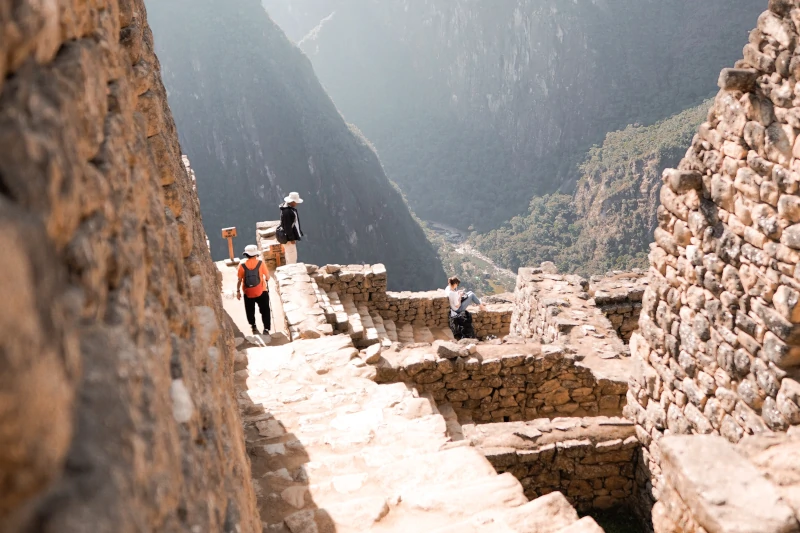Welcome to the enigmatic world of Machu Picchu, where the ancient Inca citadel rests majestically among the clouds. This UNESCO World Heritage site, nestled high in the Andean mountains of Peru, has long captivated the imagination of travelers and history enthusiasts alike. Yet, as alluring as the destination may be, navigating its ever-changing weather conditions can prove to be a challenging feat.
In this article, we’ll delve into the various meteorological moods of this iconic location, providing essential insights for your next adventure. From the awe-inspiring beauty of the sun-kissed peaks to the treacherous downpours that can dampen even the most determined explorer’s spirit, we’ll explore the full spectrum of Machu Picchu’s climatic wonders. So, strap on your hiking boots, grab your rain gear, and join us as we uncover the secrets behind the unpredictable skies of this ancient marvel.
The good: Embracing the sunshine and clear skies
Machu Picchu weather can be a traveler’s dream during the dry season. With clear skies and warm sunshine, the citadel shines in all its glory. The dry season runs from May to November, offering ideal conditions for exploring. It’s no surprise that this period attracts the majority of visitors.
Machu Picchu weather is at its finest during these months. You’ll find breathtaking views, vivid landscapes, and crisp air as you traverse the ancient ruins. The lush greenery surrounding the site is a photographer’s paradise, providing striking contrasts against the stony architecture.
Temperatures during the day hover around a pleasant 20°C (68°F), making it comfortable for hiking and sightseeing. The mornings can be cool, but as the sun rises, the warmth quickly envelops the mountains. Make sure to pack sunscreen and a hat to protect yourself from the strong sun rays.
One of the highlights of visiting during this season is witnessing the sun rise over the site. Early morning rays gently illuminate the ruins, casting a golden glow on the ancient stones. It’s a magical experience that is not to be missed.
As you plan your trip, keep in mind that Machu Picchu weather is generally predictable during the dry season. However, the high altitude can still lead to unexpected changes. It’s always wise to prepare for sudden shifts in temperature or a brief rain shower. While the dry season is the best time to experience Machu Picchu weather in all its glory, it’s also the busiest.

The bad: Navigating the rainy season and sudden fog
Machu Picchu’s rainy season stretches from December to April, with January and February being the wettest months. Although fewer crowds visit during this time, the relentless rain and persistent fog can dampen the experience. However, for intrepid explorers, it still offers a unique perspective on this ancient wonder.
The rain transforms the landscape, turning the surrounding mountains into a canvas of vibrant greens. The misty air often enshrouds the ruins, creating an air of mystery and wonder. For photographers, the fog offers an opportunity to capture surreal images of the site.
Despite the weather challenges, the rainy season is a good time to explore the nearby Sacred Valley. The region’s rich cultural heritage and stunning landscapes make it a must-visit destination. Inca ruins, local markets, and charming villages await those willing to venture beyond Machu Picchu.
For adventurous trekkers, the rainy season presents an opportunity to explore less-traveled paths. One such option is the Choquequirao trek, which leads to another magnificent Inca site. This challenging journey rewards hikers with unparalleled views and a more intimate experience. Nonetheless, be aware that during the rainy season the trail to Choquequirao becomes muddy and slippery.
Another challenging trek during the rainy season is the Salkantay Trek. This route, often considered a more scenic alternative to the Inca Trail, boasts snow-capped peaks and diverse ecosystems. However, it’s essential to be prepared for muddy trails and possible weather-related disruptions.
When navigating Machu Picchu during the rainy season, it’s crucial to pack appropriate gear. Waterproof clothing, sturdy footwear, and extra layers will ensure you’re comfortable and dry. Additionally, bring a sense of flexibility, as the weather can change rapidly.
It’s worth noting that the Inca Trail closes for maintenance every February. Travelers planning to hike this iconic route should consider alternative options during this time.

The ugly: Braving the extremes and preparing for the unexpected
Machu Picchu weather can be unpredictable, with sudden shifts in temperature, extreme conditions, and unforeseen weather events. The key to enjoying your visit is preparation and adaptability, ensuring you can embrace the experience despite any surprises.
One challenge posed by Machu Picchu weather is the high altitude. At 2,430 meters (7,972 feet) above sea level, some visitors may experience altitude sickness. Symptoms include headaches, dizziness, and shortness of breath. To minimize the risk, it’s crucial to acclimatize gradually, stay hydrated, and consider medication attention if necessary.
Sun exposure is another factor to consider in Machu Picchu weather. At high altitudes, the sun’s rays are more intense, increasing the risk of sunburn and heatstroke. Wearing sunscreen, a wide-brimmed hat, and sunglasses will help protect you from the sun’s harmful effects.
Heavy rainfall can lead to landslides and flooding in the region, occasionally affecting transportation and access to the site. Stay informed about local conditions and be prepared to adjust your plans if necessary. Travel insurance is highly recommended to cover any unforeseen disruptions.
Thunderstorms are also part of Machu Picchu weather’s unpredictable nature. When lightning is present, it’s crucial to take precautions, such as avoiding exposed areas and seeking shelter.
Preparation is key when facing Machu Picchu weather extremes. Packing a well-stocked first-aid kit, carrying extra layers of clothing, and investing in quality gear will help ensure your safety and comfort. Moreover, be ready to adapt your plans as needed.
Machu Picchu weather can present challenges, but with proper preparation and a flexible mindset, you can embrace the adventure. Remember, the unpredictability of the weather is part of what makes Machu Picchu an unforgettable experience.


